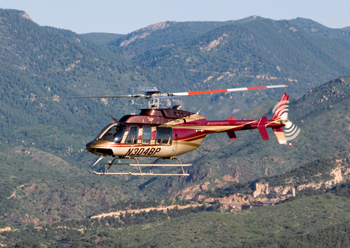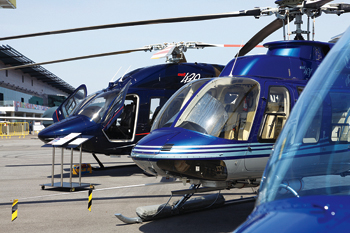Bell Helicopters Upbeat about India
Next five to eight years will see a large delivery share of helicopters in India
Neetu Dhulia from SP's AirBuz interacts with Sameer A. Rehman, Managing Director, Asia Pacific, Bell Helicopters on the sidelines of Farnborough International Airshow 2016.

Neetu Dhulia (Dhulia): What is your take on the National Civil Aviation Policy 2016 (NCAP), especially in view of the regional connectivity?
Sameer A. Rehman (Rehman): Regional connectivity in India is at the very edge of innovation right now. With the good leadership of Civil Aviation Secretary R.N. Choubey, I think it is going to be wonderful in coming three to five years, offering a great growth in the market. The NCAP offers advantage of flights under 5,000 ft to go without prior ATC clearance. It is a big contributor to connectivity and it offers efficiency by not having to go through metros all the time and India is looking outside its metros, so connectivity does take a center stage. The flight under 5,000 ft is critical as it is important to stay close to ground, for the Helicopter Emergency Medical Services (HEMS) operations and for the law enforcement agencies. It is also important for us to charter helicopter on per seat basis by sharing with few people heading in the same direction, same place at the same time.
Dhulia: How is Bell Helicopter placed in India?


Rehman: Bell helicopters enjoys largest commercial market share in India for many years now and that's not only because of the number of helicopters we have had, but also because of maintenance capabilities we offer. We have been number one for 22 years now. We take great pride in supporting helicopters after its sales. So, the essence of market support is the essence of market sustainability. Bell helicopter is both an America and Canadian company. Our contribution in India is on a couple of scales, i.e. maintenance, repair and overhaul (MRO) and our ability to support the 'Make in India' concept. We are working with Dynamatic Technologies in India an a lot of it will depend upon the Defence Procurement Procedure (DPP) and the way it is structured especially now with the strategic partnership model, that Raksha Mantri has put out with Prime Minister Narendra Modi's blessings, so we have to understand what is going on and how this is going to impact our ability to manage these programmes within India.
Dhulia: Could you elaborate on 'Make in India'?
Rehman: Bell Helicopter is forging new partnerships in accordance with 'Make in India' initiative. Bell Helicopter is working through its Textron affiliate TIPL, and we look forward to continue the momentum we have established with Dynamatic. They delivered their first major aero structures for the Bell 407 in early 2015 and became the single source supplier of major airframe assemblies for the Bell 407GXP and 407GT.
Essence of market support is the essence of market sustainability.
Dhulia: And the MRO?
Rehman: Today we have customer service facility in India by the name of 'Air Works'. It is the Bell authorised service facility. MRO support is indigenous, but the spare support comes from Singapore. MRO is slated to grow! The total installed fleet of helicopters in India today is 300 plus. The essence for Bell and every other manufacture in India is going to be maintenance and repair, there is no other way about it. India is not the traditional market of use and replace, we have to find a way to keep helicopters flying.
Dhulia: Does Bell provide the training?
Rehman: Bell helicopters are very comprehensive in that. We provide pilot training, field maintenance training, avionics training, electric/AFCS training and recurrence trainings as per the DGCA requirements. Our major hub in Asia is in Singapore, where we have a 17,000 square metre facility for component repair and overhaul CRO, MRO and training.
Dhulia: How do you foresee the rotor wings growth in India?
Rehman: Being of Indian origin myself, I have lots of faith in India. India has a GDP of plus 6 per cent, which is largest in the world today. It makes me very proud to say, that I think one day, especially now with the NCAP and the new medical evacuation guidelines, the expected growth will be in the private and the public sector. I think we will have very large delivery share of the helicopters in the next five to eight years.
Dhulia: Which sectors do you think will be driving the growth for civilian helicopter market in India?
Rehman: There are three market segments that we are placing significant focus on and that includes law enforcement, emergency medical services and search and rescue operations. We're very optimistic about the emergency medical service market, with the new NCAP.





